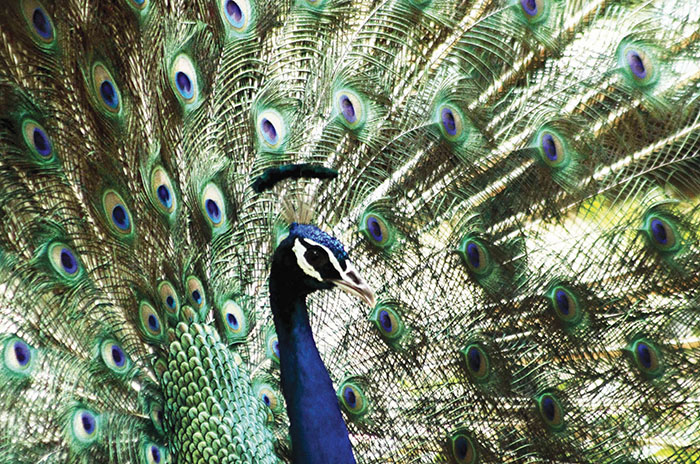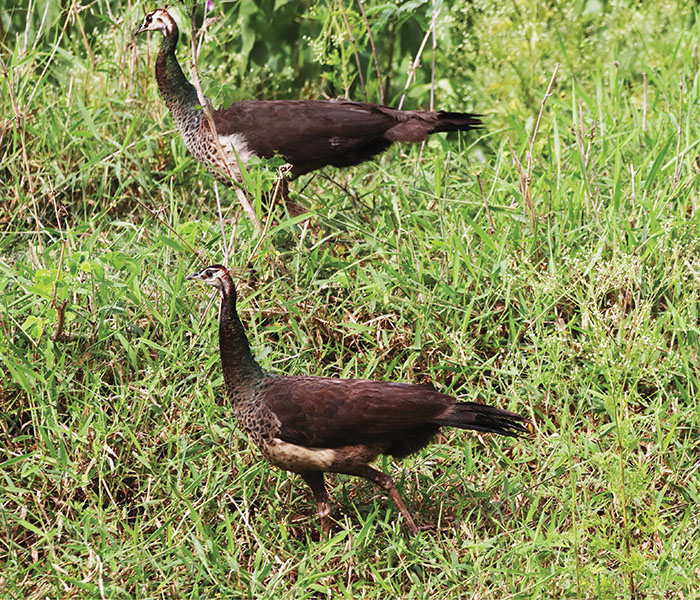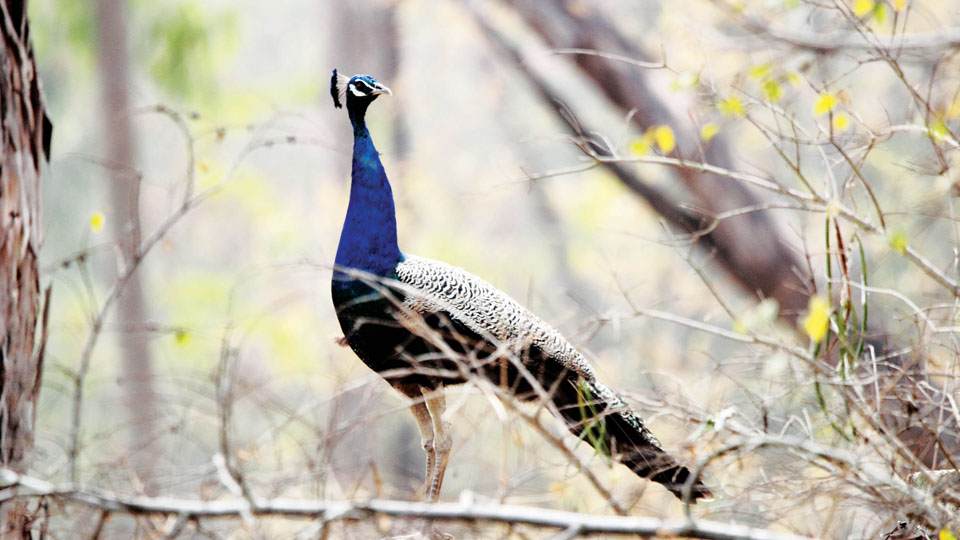Lack of human movement due to COVID lockdowns, curfews one of the reasons
Mysore/Mysuru: Peacock population in and around Mysuru has increased, bringing cheer among bird lovers and residents.
Chamundi Hill, Lalithadripura, Hebbal Lake, Kukkarahalli Lake, Lingambudhi Lake, Vijayanagar Third Stage, Hebbal Industrial Area, Lalitha Mahal premises, Mahadevapura and villages like Varakodu, Alanahalli, Bhugathahalli and surrounding areas are teeming with peacocks and their sighting is not rare anymore.
Tourists and devotees flocking Chamundi Hill have increasingly spotted this bird as the ecosystem perfectly supports the species with its 1,516-acre protected area. Residents living atop the Hill and below are seeing the bird perched on trees, rooftops and even on the ground and on the winding roads.
Even the nearby estates surrounding Chamundi Hill have become places to see the bird of late and the residents said that since the last five years, there has been an increase in the peacock population. But the Forest Department has no data on the exact bird count indicating the increase though officials too admit that the population has seen a rise substantially.

Threat from poachers
Forest officials said that one of the reasons for them to not publish the data is due to the fear that the National Bird will be targeted by poachers.
Their feathers are a prized commodity and poachers do not hesitate to kill the bird if the exact areas are pinpointed.
Apart from protecting the fragile ecosystem, flora and fauna of Chamundi Hill, the Department has planted several fruit-bearing trees and have desilted many waterholes and this might have contributed to the increase in the number of peacocks and other birds.
Encouragingly, the green cover on the Hill has increased and now people do not venture into the forests to collect firewood as they fear leopards.
Need to study numbers
Speaking to Star of Mysore, amateur naturalist and bird photographer M.K. Sapthagirish said that there is a need for a study on why these peacocks are increasingly found in places of human habitation. “One of the reasons being the food resource might have increased. Also, their population could have seen a jump,” he said.
The concentration of peacocks at one place is due to the availability of food. They forage around and they are found in one place for three months or so. “If there is a massive increase in the population, there are chances of natural and ecological imbalance. Peacocks feed on snakes — a regular diet — and if they eat up all the snakes, then the rodent population will increase. We need to observe and study and then come to a conclusion without offering a knee-jerk reaction,” he explained.

Lockdowns, curfews facilitated peacocks to thrive: Ethologist
According to city-based Ethologist Ragoo Rao, Mysuru had never seen peacock flocks entering urban localities. Though peacocks were sighted occasionally in the fringe areas — at least two to three kilometres away from the settlements, in agricultural locales (more frequently in the drier months with not much human activity in the fields) — the birds had not dared or taken the risk of entering human settlements.
“I think lockdowns, curfews and other restrictions on movement facilitated peacocks’ entry into human habitats. “Perhaps it was comfortable for them to walk into towns and streets in search of forage, without the fear of being harmed. Gradually from the fringe areas, they started entering deep into the townships. As days passed into months and years, peacocks started losing the fear of humans and though they kept a safe distance, they did not move away from humans,” he said.
Bold individuals ventured into some compounds in the Chamundi Hillside residential locality, much to the amusement of the residents.
“Since peacocks are held in high respect and esteem, the birds were welcomed and some compounds even offered them water and grains. Even the birds accepted them but remained wary,” he added.








We should Criminalise Hunting and consumption of peacock. People who kill it for its feathers should be caught and jailed, the people who eat it are downright barbarians.
To me, all meat eaters are barbarians, when there is so much plant-based food is available and healthy too.
To me, all meat eaters are barbarians, when there is so much plant-based food is available and healthy too.
Sir its a sign of global warming, peacocks mostly found in places where humidity n temperature is more, Mysuru climate is also changing, its a warning, we have to plant n protect more trees
Maybe, peahens are drinking more tears of the peacocks?
Tor the background story, please read below the extracted summary from news18 of may 2017
Judge told TV channels that “the peahen gets pregnant” only by “swallowing the tears of the peacock”. He made the remark to back his observation that cows should replace the tiger as the national animal because “it’s also holy”. Experts have rejected his claims.